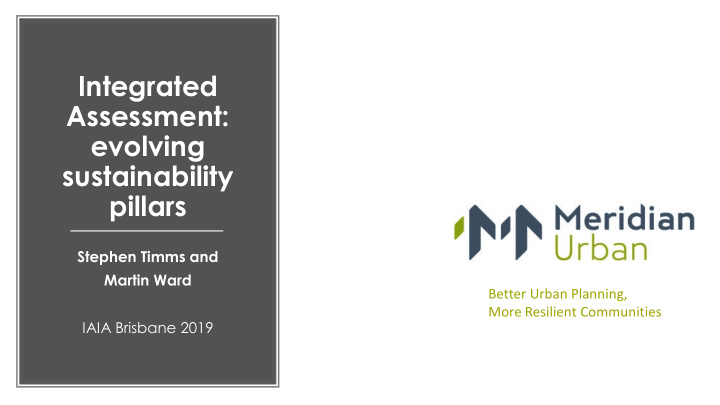



Integrated Assessment: evolving sustainability pillars Stephen Timms and Martin Ward Better Urban Planning, More Resilient Communities IAIA Brisbane 2019
NZ’s largest natural disaster • 3rd largest insurance claim in the world • 170,000 building claims – 19% over $100,000 cap • 7,187 properties ‘red zoned’ = 636ha of land • Rebuild around $45 billion (roughly 20% NZ GDP) • Tohoku, Japan earthquake – roughly 4.6% GDP • Queensland floods – roughly 1% GDP • First major earthquake to hit an urban centre in NZ since Napier 1931 • Plans, strategies and programmes urgently needed to expedite recovery
What is Integrated Assessment? • A formal approach used to predict the potential effects of a policy, with particular attention paid to impacts on health and wellbeing; in addition to social, economic, cultural and environmental matters • Designed to inform development of plans and policies through early iterations • A collaborative multi-agency and cross disciplinary approach
What’s in a name? • Impact Assessment; Integrated Assessment; Sustainability Assessment; Strategic Environmental Appraisal; Regulatory Impact Statement; Section 32 Analysis; Health in all policies approach …? • Sustainability Appraisal recognised as having clear ‘four pillar’ approach as the foundation • Integrated Assessment used as generic label
The framework approach • Developed for New Zealand application by Barry Sadler and Martin Ward. • Sustainability Appraisal involves baseline tests relating to four pillars • social • economic • environmental • cultural • A sustainability test is undertaken against both: • a top line of objectives/targets/norms to aim for, and • a bottom line of key thresholds (base minima) or warning signs to avoid.
Integrated Assessment – basic steps Establish assessment frame, what are we assessing for? Develop assessment criteria Workshop criteria, plus top & bottom lines Testing’ early iterations of the plan using criteria Re-apply assessment criteria if useful to later draft (s)
1. Sustainability Appraisal of the Canterbury Water Management Strategy (CWMS), 2009 Canterbury Regional Council 2. Wellbeing Assessment of the Castle Plaza Development Plan Amendment, 2011 City of Marion (Adelaide) and South Australia Department of Health 3. Sustainability and Wellbeing Assessment of the Draft Christchurch Central Integrated City Plan, 2012 CERA, Christchurch City Council & CDHB Assessment roll 4. Integrated Assessment of the Draft Land Use Recovery Plan, 2013 Canterbury Regional Council & CDHB call: 5. Wellbeing Impact Assessment of the Draft Lyttelton Port Recovery Plan, 2014 Canterbury Regional Council, Port of Lyttelton & CDHB 6. Integrated Assessment of the Draft Waimakariri Residential Red Zone, 2015 CERA, Waimakariri District Council & CDHB 7. Integrated Assessment of the Otakaro/Avon River Corridor Plan, 2018 Regenerate Christchurch, CDHB & others
Developing assessment criteria • Provisional work by a small specialist assessment team to: • Identify capital assets under four pillars • Develop assessment criteria to be used (from existing planning & policy framework) • Agree scale (e.g. -1 to +3) • Compose preliminary descriptors
Workshops • Agree capital asset sets and criteria elements • Amend/confirm assessment criteria and scale descriptors • Set top and bottom lines • ‘Score’ the plan/project options • One, two or three workshops have been used
Example ‘scoring’ of the draft plan Red circle = bottom line; Blue box = top line Green cross is where the participants ‘scored’ the draft plan
Greater Christchurch Land Use Recovery Plan - summary of recommendations
IA was a success because: • Early in the process • Involved plan writers and those advising decision makers early (so not defending the plan, but open to ideas) • Used pre-established criteria • Efficient for testing early ideas (time, resourcing, budgets) • Useful for defending challenges (legal, political, community)
Lessons Allow lead in time Good facilitator is essential Need a ‘champion’ to promote/explain IA Collaboration/consensus building requires good relationships (trust & time/effort) Planning is inherently political
• Compositional bias will introduce a content and outcome bias • The most helpful participants are likely to be busy and will show participant fatigue • Need to understand equity issues (and Appropriate the social determinants of health and participation wellbeing) • And ‘speak’ for future generations • Need an understanding of resource (capital) asset management and the notion of capital substitution • Mana whenua must be involved
Legacy A positive participative approach to plan making More robust and transparent ‘testing’ of plan development Saves time/money/resources (esp. post disaster) Collaborative multi-agency planning processes Mana whenua involvement now the norm Contributes to better plans for health and wellbeing of community Better urban planning, more resilient communities
Where next for Integrated Assessment? • Refine base methodology with interested practitioners • Finalise a ‘how to’ guide • Further promotion and capacity building for: • IA practitioners and potential exponents • Urban planners and allied professions • Management/commissioning decision makers • Potential use in Australia and further afield
Thank you Stephen Timms Principal Meridian Urban stephen.timms@meridianurban.com m. +61 (0) 429 039 189
Recommend
More recommend